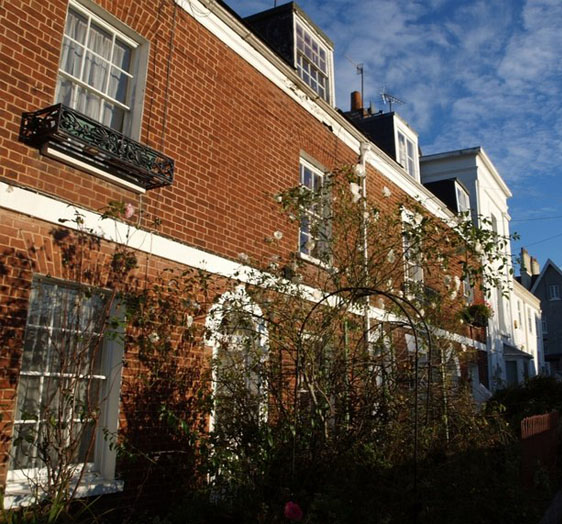Researched by Heritage Advisory Group
The frontages of Russell Terrace are enclosed by a high brick wall, which forms the boundary to the Richmond Road car park. The area has a verdant character and tranquil ambience. The houses have architectural details in a plain and unassuming vernacular classical style, including semi-circular fanlights with keystones over the doorways, plain plat bands marking the floor levels and square-headed sash windows with cast-iron window boxes at first-floor level.
Unlike the stucco frontages of most houses of the early Victorian period, these houses feature exposed brickwork and are thus rather old-fashioned for their date. Although modest in scale they reflect the architectural character of much grander houses built for gentry and merchant families in Southernhay and Barnfield Crescent in the 1790s and early 1800s. The terrace was constructed in the late 1840s.
On 30 March 1851 the census enumerator found three of the houses empty and the remainder were occupied by railway employees, a journeyman bookbinder and a goldsmith’s assistant. There were no indoor servants.
In 1871 the terrace was occupied mostly by Westcountry men and women who, again, did not have indoor servants. Their occupations were similar to those twenty years before; they included solicitors’ clerks, a telegraph clerk, a needlewoman, an engine driver and a ‘shop man’.
That year an unusual event took place between the residents of Numbers Six and Seven. Mrs Channing, who was described as an elderly lady in a newspaper report, but noted by the census enumerator as being sixty-seven-years-old, was prosecuted for her behaviour. She was charged in court for maliciously pulling down a wire fence in her neighbour’s garden.
James Allen, a forty-six-year-old married silversmith from Cornwall, had erected `an ingenious wire fence intermixed with numerous spikes to keep cats’ from damaging his plants. Mrs Channing was found guilty and fined six shillings (£18.78 in today’s money).
